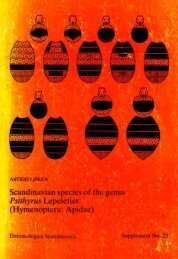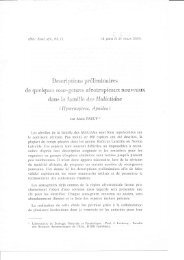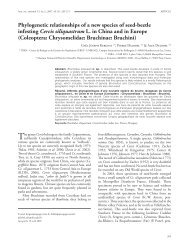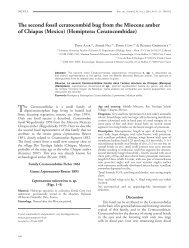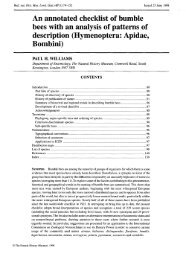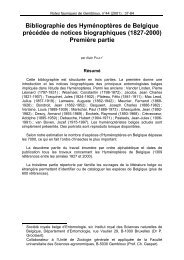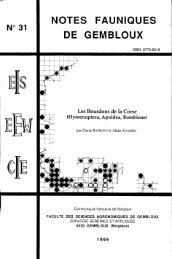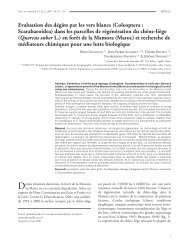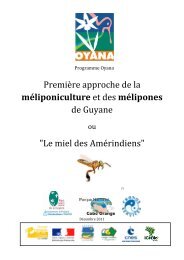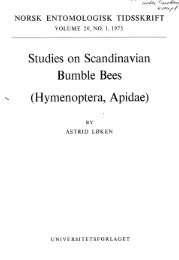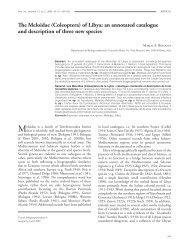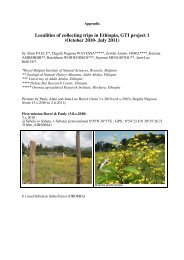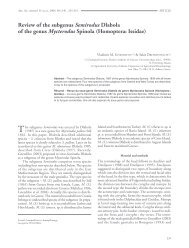J. Prokop & A. NelDerivation of name. Named after magnificent state ofpreservation, <strong>elegans</strong> in Latin.Type locality. Ovčín opencast mine near Radnice,Radnice Basin, Czech RepublicType strata. Upper <strong>Carboniferous</strong>, Westphalian B-C,Bolsovian, Kladno Formation, Radnice Member, LowerRadnice Coal, Whetstone Horizon.Description. Negative imprint of a fore and ahindwing in life position, probably hyaline. Forewingbroadest part at about midwing; length of fragmentto first distortion break about 115 mm, probable totallength about 260 mm; wing width 49 mm; estimateratio (wing length/width) about 5.3; precostal area ofCA and CP not preserved, but ScA is certainly shortas it is absent above arculus level; simple concave ScPnearly parallel to anterior wing margin, and reaching itin apical part of wing, at least distal of 190 mm <strong>from</strong>wing base, but extreme apex of ScP not preserved; ninevisible ‘antenodal’ cross-veins in area between ScP andC, more or less aligned with cross-veins in area betweenScP and RA; <strong>the</strong> most basal cross-vein perpendicular toC, ScP, and RA, stronger than o<strong>the</strong>rs ‘antenodals’, andmaking a distinct brace corresponding to <strong>the</strong> primaryantenodal cross-vein Ax0 not preserved; ‘subnodus’between RA and RP near base of RP2; stem of radialveins dividing 34 mm <strong>from</strong> wing base forming ‘arculus’,RA strong, simple, parallel to ScP, and ending probablyin wing apex; R and MA fused in <strong>the</strong>ir basal parts; RPbifurcating into RP1/2 and RP3/4 88 mm <strong>from</strong> wingbase; only basal part of RP3/4 preserved, simple; IR2and o<strong>the</strong>r distal branches of RP partly preserved onisolated apical part; MA nearly straight with its mostbasal posterior branches partly preserved, first oppositebifurcation between RP1/2 and RP3/4; only fragmentsof MP vein preserved and visible at level of arculus,its medial part being hidden under rock, but MPprobably simple; at least CuA forming strongly obliquecross-vein but remains of an oblique cross-vein CuPalso visible in area between MP and AA, CuP 15 mm<strong>from</strong> wing base, CuA one cell distally; CuP separating<strong>from</strong> CuA 36 mm <strong>from</strong> wing base and six cells distal ofCuP-crossing; distal part of CuA with numerous mainposterior branches; CuP very long and ra<strong>the</strong>r straight,with four main simple posterior branches covering arelatively small area, basal part before its first furcationlong and straight, about 4 mm long, width of area ofCuP along posterior wing margin 51 mm; distal partof AA forming a relatively large are, width of this arealong posterior wing margin 49 mm; basal part of AA(+ Cu) forming a very weak curve; anal and cubitoanalareas ra<strong>the</strong>r broad, 17 mm wide, with numerousposterior branches.The preserved parts of <strong>the</strong> hindwing are verysimilar to <strong>the</strong> forewing in pattern of venation exceptfor <strong>the</strong> cubito-anal area, hindwing slightly broaderthan forewing; length of wing fragment about 85 mm,probable total length as about fore wing; wing width50 mm; estimated ratio (wing length/width) 5.2; analand cubito-anal areas distinctly broader than in <strong>the</strong>fore wing, 30 mm wide; preserved basal part of CuPlong and nearly straight but distal part not preserved;distal part of AA forming a relatively large area with8–9 main posterior branches.DiscussionThis Odonatoptera is clearly related to <strong>the</strong>Meganisoptera that comprises <strong>the</strong> ‘families’Namurotypidae Bechly 1996, MeganeuridaeHandlirsch 1906, Kohlwaldiidae Guthörl 1962, andParalogidae Handlirsch 1906. Relationships with <strong>the</strong>Namurotypidae are excluded because <strong>Bohemiatupus</strong>n. gen. has a distally branched CuP, instead of beingsimple. The Paralogidae have a long and straight CuP asin <strong>Bohemiatupus</strong> n. gen., but with numerous branchescovering a broader area than CuA and distal branchof AA. The Kohlwaldiidae are characterized by having<strong>the</strong> distal parts of CuP and AA strongly reduced,which is not <strong>the</strong> case of <strong>Bohemiatupus</strong> n. gen. (Nel etal. 2009). The Meganeuridae are characterized by <strong>the</strong>presence of a typical ‘subnodal’ oblique vein betweenRA and RP near <strong>the</strong> base of RP2, which is preservedin our fossil. The very large size of <strong>Bohemiatupus</strong> n.gen. supports affinities with this family even if severalMeganeuridae have distinctly smaller dimensions(Nel et al. 2009). <strong>Bohemiatupus</strong> n. gen. cannot beattributed to <strong>the</strong> Meganeurinae because its vein ScA isshort. The Carpentertypinae Zessin 1983 [type genusCarpentertypus Zessin 1983, based on one speciesC. durhami (Carpenter 1961)] is based on a veryfragmentary fossil, with no information on any of <strong>the</strong>basal halves of <strong>the</strong> wings. Never<strong>the</strong>less it differs <strong>from</strong><strong>Bohemiatupus</strong> n. gen. in its distinctly less numerous cellsand narrower area covered by MA. The PiesbergtupinaeZessin 2006 (type genus Piesbergtupus Zessin 2006) ischaracterized by <strong>the</strong> narrow anal area of fore wing andpresence of one oblique cross-vein distal of <strong>the</strong> obliquebraces CuP and CuA and basal of <strong>the</strong> distal branch ofCuP re-emerging <strong>from</strong> CuA+CuP, plus <strong>the</strong> long CuPand AA1 (Zessin 2006, 2008; Nel et al. 2009). Thepattern of wing venation of <strong>Bohemiatupus</strong> n. gen. fitsvery well with <strong>the</strong> Tupinae. The monophyly of this lastgroup is not very clearly established (Bechly 1996; Nelet al. 2009), but we can now restrict <strong>the</strong> comparison of<strong>Bohemiatupus</strong> n. gen. to <strong>the</strong> genera that are currentlyattributed to it. After <strong>the</strong> key to <strong>the</strong> tupine genera ofNel et al. (2009), <strong>Bohemiatupus</strong> n. gen. would fall186
<strong>New</strong> <strong>Late</strong> <strong>Carboniferous</strong> <strong>griffenfly</strong> in western Bohemianear <strong>the</strong> Permian genus Tupus Sellards 1906 becauseof <strong>the</strong> following characters: <strong>the</strong> two braces CuP andCuA oblique, not fused into a long, oblique vein; AA1with several posterior branches; and CuP with morethan three concave branches. <strong>Bohemiatupus</strong> n. gen.greatly differs <strong>from</strong> Tupus in its hindwing cubito-analarea distinctly broader than that of fore wing. Some‘enigmatic’ genera are based on incomplete wings, i.e.<strong>the</strong> <strong>Carboniferous</strong> genera Shenzhousia Zhang et al.2006 and Boltonites Handlirsch 1919, and <strong>the</strong> PermianPetrotypus Zalessky 1950. Petrotypus needs a completeredescription, and it is based on a very poor fossil.Never<strong>the</strong>less, its CuP seems to be simple and verystraight after Zalessky (1950), unlike <strong>Bohemiatupus</strong> n.gen. Shenzhousia shares with <strong>Bohemiatupus</strong> n. gen. avery long and straight CuP but with numerous posteriorbranches covering a broad area, unlike <strong>Bohemiatupus</strong>n. gen. (Zhang et al. 2006). After <strong>the</strong> figure of Bolton(1922: fig. 44), Boltonites has a distinctly curved CuP,shorter than that of <strong>Bohemiatupus</strong>.Conclusions<strong>Bohemiatupus</strong> n. gen. is established for <strong>Bohemiatupus</strong><strong>elegans</strong> n. sp. (type species) that exhibits uniquecombination of characters within Meganeuridae. Thepresent discovery represent <strong>the</strong> first record of large<strong>griffenfly</strong> <strong>from</strong> <strong>the</strong> continental basins of <strong>the</strong> BohemianMassif supplementing <strong>the</strong> o<strong>the</strong>r giant insects suchas Bojophlebia prokopi Kukalová-Peck 1985 orCarbotriplura kukalovae Kluge 1996 <strong>from</strong> <strong>the</strong> samestrata.Moreover, <strong>the</strong> material <strong>from</strong> Ovčín near Radnicerepresents an extraordinary source of fossil plants in situand o<strong>the</strong>r animals like arachnid, fish and amphibiantrace fossils those enable study of developed peatmire ecosystem into a shallow lake gradually filled byredeposited volcanic ash <strong>from</strong> Bolsovian of westernBohemia (Czech Republic).Acknowledgements. The authors are grateful to Radek Labuťa(National Museum in Praha) who discovered <strong>the</strong> present specimenand to group of <strong>the</strong> Czech paleobotanits so called “Czechmafia” for large excavations at Ovčín locality. We especiallythank to Josef Pšenička (West Bohemian Museum in Plzeň) for<strong>the</strong> loan of <strong>the</strong> material. The first author (JP) acknowledges <strong>the</strong>research support <strong>from</strong> <strong>the</strong> Grant Agency of Academy of <strong>the</strong>Czech Republic No. KJB301110701 and Ministry of SchoolsMSM 0021620828. We sincerely thank Dr Gun<strong>the</strong>r Fleck forhis useful comments on <strong>the</strong> first version of <strong>the</strong> paper.ReferencesBechly G. 1996. Morphologische Untersuchungen am Flügelgeäder derrezenten Libellen und deren Stammgruppenvertreter (Insecta; Pterygota;Odonata), unter besonderer Berücksichtigung der PhylogenetischenSystematik und des Grundplanes der Odonata. Petalura BöblingenSpecial Volume 2: 1-402.Bechly G. 2007. Phylogenetic systematics of Odonata. Homepage on Internet.http://www.bernstein.naturkundemuseum-bw.de/odonata/index.htmBechly G., Brauckmann C., Zessin W., Gröning E. 2001. <strong>New</strong> results concerning<strong>the</strong> morphology of <strong>the</strong> most ancient dragonflies (Insecta: Odonatoptera)<strong>from</strong> <strong>the</strong> Namurian of Hagen-Vorhalle (Germany). Zeitschriftfür Zoologische Systematik und Evolutionsforschung 39: 209-226.Bolton H. 1922. A monograph of <strong>the</strong> fossil insects of <strong>the</strong> British coalmeasures. Palaeontographical Society Monograph London 74: 81-156.Brauckmann C., Zessin W. 1989. Neue Meganeuridae aus dem Namuriumvon Hagen-Vorhalle (BDR) und die Phylogenie des Meganisoptera.Deutsche Entomologische Zeitschrift (N.F.) 36: 177-215.Carpenter F. M. 1939. The Lower Permian insects of Kansas. Part 8. AdditionalMegasecoptera, Protodonata, Odonata, Homoptera Psocoptera,Plecoptera, and Protoperlaria. Proceedings of <strong>the</strong> American Academy ofArts and Sciences 73: 29-70.Carpenter F. M. 1947. Lower Permian insects <strong>from</strong> Oklahoma. Part 1. Introductionand <strong>the</strong> orders Megasecoptera, Protodonata, and Odonata.Proceedings of <strong>the</strong> American Academy of Arts and Sciences 76: 25-54.Fritsch A. 1880. Dva noví členovci z útvaru kamanouhelného v Čechách [Twonew arthropods <strong>from</strong> <strong>the</strong> coal system in Bohemia.]. Vesmir 9: 241-242.Fritsch A. 1901. Fauna der Gaskohle und der Kalksteine der PermformationBöhmens. Bd. IV, Prag, 92 pp.Handlirsch A. 1920. Beiträge zur Kenntnis der Palaeozoischen Blattarien.Sitzungberichte der Akademie der Wissenschaften, Ma<strong>the</strong>matisch-Naturwissenschaftliche Klasse, Wien, (1), 129: 8.Jarzembowski E. A., Nel A. 2002. The earliest damselfly-like insect and <strong>the</strong>origin of modern dragonflies (Insecta: Odonatoptera: Protozygoptera).Proceedings of <strong>the</strong> Geologist’s Association 113: 165-169.Kukalová J. 1955. Permoedischia n. gen. (Protorthoptera) a Moravipteran. gen. (Palaeodictyoptera) z moravskeho permu. Sborník ÚstředníhoÚstavu Geologického, oddil Paleontologický 21: 541-575.Kukalová J. 1958. Paoliidae Handlirsch (Insecta, Protorthoptera) aus demOberschlesichen Steinkohlenbecken. Geologie 7: 935-959.Kukalová-Peck J. 1985. Ephemeroid wing venation based upon new gigantic<strong>Carboniferous</strong> mayflies and basis morphological phylogeny andmetamorphosis of pterygopte insects (Insecta, Ephemerida). CanadianJournal of Zoology 63: 933-955.Kušta J. 1883. Über einige neue böhmische Blattinen. Sitzungberichte KoniglicheBöhmische Gesellschaft Wissenschaften, Pragae 1883: 211-215.Libertín M., Opluštil S., Pšenička J., Bek J., Sýkorová I., Dašková J.2009. Middle Pennsylvanian pioneer plant assemblage buried insitu by volcanic ash-fall, central Bohemia, Czech Republic. Review ofPalaeobotany and Palynology 155(3-4): 204-233.Nel A., Garrouste R., Roques P. 2008. A new <strong>griffenfly</strong> genus <strong>from</strong> <strong>the</strong><strong>Late</strong> <strong>Carboniferous</strong> of nor<strong>the</strong>rn France (Odonatoptera: Meganeuridae).Insect Systematics & Evolution 39: 231-239.Nel A., Fleck G., Garrouste R., Gand G., Lapeyrie J., Bybee S. M.,Prokop J. 2009. Revision of Permo-<strong>Carboniferous</strong> griffenflies (Insecta:Odonatoptera: Meganisoptera) based upon new species andredescription of selected poorly known taxa <strong>from</strong> Eurasia. Palaeontographica(A) 289: 89-121.Nel A., Martínez-Declòs X., Paicheler J.-C., Henrotay M. 1993. Les‘Anisozygoptera’ fossiles. Phylogénie et classification (Odonata).Martinia Numéro Hors Série 3: 1-311.Novák O. 1880. Ueber Gryllacris Bohemica, einen neuen Locustiderenrestaus der Steinkohlenformation von Stradonitz in Böhmen. Jahrbuch derk.k. Geologischen Reichsanstalt 30: 69-75.Opluštil S., Pšenička J., Libertín M., Šimůnek Z. 2007. Vegetationpatterns of Westphalian and Lower Stephanian mire assemblages preservedin tuff beds of <strong>the</strong> continental basins of Czech Republic. Reviewof Palaeobotany and Palynology 143: 107-154.Opluštil S., Pšenička J., Libertín M., Bashforth A. R., Šimůnek Z.,Drábková J., Dašková J. 2009. A Middle Pennsylvanian (Bolsovian)peat-forming forest preserved in situ in volcanic ash of <strong>the</strong> WhetstoneHorizon in <strong>the</strong> Radnice Basin, Czech Republic. Review of Palaeobotanyand Palynology, 155 (3-4): 234-274.187



